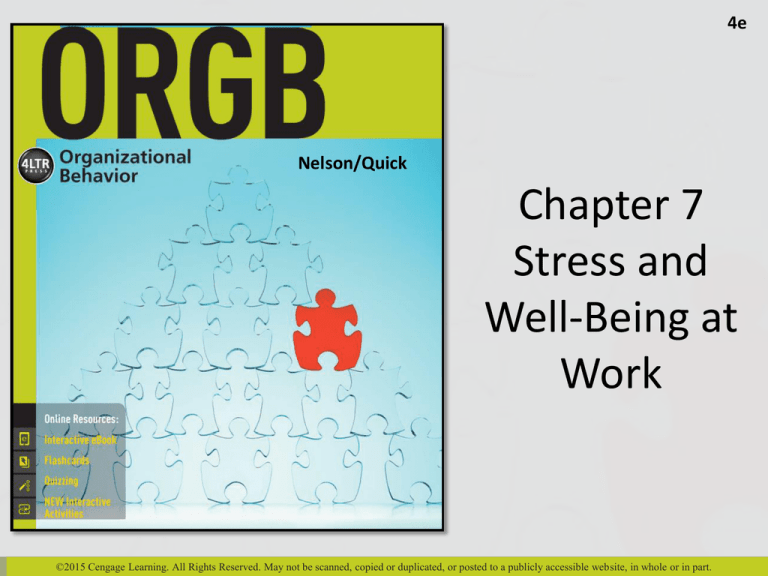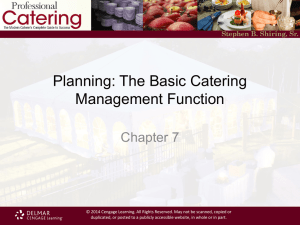
4e
Nelson/Quick
Chapter 7
Stress and
Well-Being at
Work
©2015 Cengage Learning. All Rights Reserved. May not be scanned, copied or duplicated, or posted to a publicly accessible website, in whole or in part.
Learning Outcomes
Define stress, distress, and strain
Compare four different approaches to stress
Explain the psychophysiology of the stress response
Identify work and nonwork causes of stress
Describe the consequences of stress
©2015 Cengage Learning. All Rights Reserved. May not be scanned, copied or duplicated, or posted to a publicly accessible website, in whole or in part.
2
Learning Outcomes
Discuss individual factors that influence a person’s
response to stress and strain
Identify the stages and elements of preventive
stress management for individuals and
organizations
©2015 Cengage Learning. All Rights Reserved. May not be scanned, copied or duplicated, or posted to a publicly accessible website, in whole or in part.
3
What Is Stress?
Unconscious preparation to fight or flee that a
person experiences when faced with any demand
Stressor: Person or event that triggers the stress
response
Distress or strain: Adverse psychological, physical,
behavioral, and organizational consequences that
may arise as a result of stressful events
©2015 Cengage Learning. All Rights Reserved. May not be scanned, copied or duplicated, or posted to a publicly accessible website, in whole or in part.
4
4 Approaches to Stress
Homeostatic/medical approach
Stress occurs when an external, environmental
demand upsets an individual’s natural steady-state
balance
Homeostasis: Steady state of bodily functioning and
equilibrium
©2015 Cengage Learning. All Rights Reserved. May not be scanned, copied or duplicated, or posted to a publicly accessible website, in whole or in part.
5
Cognitive Appraisal
Problem-focused coping emphasizes managing
the stressor
Emotion-focused coping emphasizes managing
your response
©2015 Cengage Learning. All Rights Reserved. May not be scanned, copied or duplicated, or posted to a publicly accessible website, in whole or in part.
6
Person-Environment Fit
Confusing and conflicting expectations of a person
in a social role create stress
Person-environment fit occurs when one’s skills and
abilities match a clearly defined set of role
expectations
©2015 Cengage Learning. All Rights Reserved. May not be scanned, copied or duplicated, or posted to a publicly accessible website, in whole or in part.
7
Psychoanalytic
Stress results from the discrepancy between the
idealized self (ego-ideal) and the real self-image
Ego-ideal: Embodiment of a person’s perfect self
Self-image: How a person sees himself or herself,
both positively and negatively
Discrepancy between the two elements of
personality is directly proportional to the amount of
stress experienced
©2015 Cengage Learning. All Rights Reserved. May not be scanned, copied or duplicated, or posted to a publicly accessible website, in whole or in part.
8
The Stress Response
Release of chemical messengers
Activation of sympathetic nervous
and endocrine system
Triggering of mind-body changes that
prepare the person for fight or flight
©2015 Cengage Learning. All Rights Reserved. May not be scanned, copied or duplicated, or posted to a publicly accessible website, in whole or in part.
9
Table 7.1 - Work and Nonwork
Demands
©2015 Cengage Learning. All Rights Reserved. May not be scanned, copied or duplicated, or posted to a publicly accessible website, in whole or in part.
10
Table 7.1 - Work and Nonwork
Demands
©2015 Cengage Learning. All Rights Reserved. May not be scanned, copied or duplicated, or posted to a publicly accessible website, in whole or in part.
11
Positive Stress
Some stressful activities enhance a person’s ability
to manage stressful situations
Stress can provide a needed energy boost
Yerkes-Dodson law - Indicates that stress leads to
improved performance up to an optimum point
©2015 Cengage Learning. All Rights Reserved. May not be scanned, copied or duplicated, or posted to a publicly accessible website, in whole or in part.
12
Individual Distress
Medical illness
• Heart disease, strokes, peptic ulcers, headaches, and
backaches
Behavioral problems
• Substance abuse, violence, accidents
Work-related psychological disorders
• Depression, burnout, psychosomatic disorders
©2015 Cengage Learning. All Rights Reserved. May not be scanned, copied or duplicated, or posted to a publicly accessible website, in whole or in part.
13
Organizational Distress
Participation problem: Cost associated with
absenteeism, tardiness, strikes and work stoppages,
and turnover
Performance decrement: Cost resulting from poor
quality or low quantity of production, grievances,
and unscheduled machine downtime and repair
Compensation award: Organizational cost resulting
from court awards for job distress
©2015 Cengage Learning. All Rights Reserved. May not be scanned, copied or duplicated, or posted to a publicly accessible website, in whole or in part.
14
Individual Differences
Achilles’ heel phenomenon - Person breaks down at
his or her weakest point
Extraversion and neuroticism affect the stress-strain
relationship
©2015 Cengage Learning. All Rights Reserved. May not be scanned, copied or duplicated, or posted to a publicly accessible website, in whole or in part.
15
Gender Effects
Sexual harassment is a source of stress for working
women
Males are more vulnerable at an earlier age to fatal
health problems
Women are more vulnerable to nonfatal but longterm health problems
©2015 Cengage Learning. All Rights Reserved. May not be scanned, copied or duplicated, or posted to a publicly accessible website, in whole or in part.
16
Self-Reliance
Healthy, secure, interdependent pattern of behavior
related to how people form and maintain
supportive attachments with others
Counterdependence: Unhealthy, insecure pattern
of behavior that leads to separation in relationships
with other people
Overdependence: Unhealthy, insecure pattern of
behavior that leads to preoccupied attempts to
achieve security through relationships
©2015 Cengage Learning. All Rights Reserved. May not be scanned, copied or duplicated, or posted to a publicly accessible website, in whole or in part.
17
Figure 7.2 - Framework for
Preventative Stress Maintenance
SOURCE: J. D. Quick, R. S. Horn, and J. C. Quick, “Health Consequences of Stress,” Journal of Organizational Behavior Management 8, No. 2 (Fall
1986): 21. Reprinted by permission of (Taylor & Francis Ltd, http://www.tandf.co.uk/journals).
©2015 Cengage Learning. All Rights Reserved. May not be scanned, copied or duplicated, or posted to a publicly accessible website, in whole or in part.
18
Figure 7.3 - Job Strain Model
SOURCE: Republished with permission of ABC-CLIO Inc., from Work Stress: Health Care Systems in the Workplace, J. C. Quick, R. S. Bhagat, J. E.
Dalton, and J. D. Quick. © 1987; permission conveyed through Copyright Clearance Center, Inc.
©2015 Cengage Learning. All Rights Reserved. May not be scanned, copied or duplicated, or posted to a publicly accessible website, in whole or in part.
19
Figure 7.4 - Social Support at Work
and Home
SOURCE: J. C. Quick, J. D. Quick, D. L. Nelson, and J. J. Hurrell, Jr., Preventive Stress Management in Organizations (Washington, D.C.:
American Psychological Association, 1997), 198. Reprinted with permission.
©2015 Cengage Learning. All Rights Reserved. May not be scanned, copied or duplicated, or posted to a publicly accessible website, in whole or in part.
20








